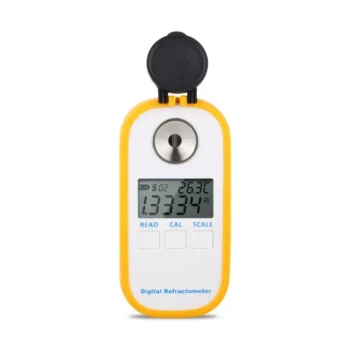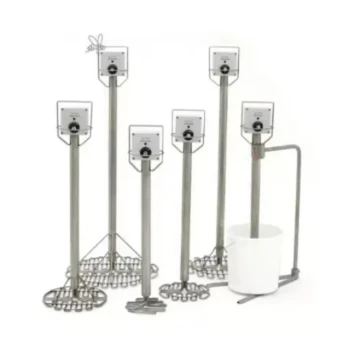Beyond measuring the moisture content of honey, a refractometer is a versatile instrument with critical applications across the food and beverage industry, scientific laboratories, automotive maintenance, and even gemology. Its fundamental purpose is to measure the concentration of a dissolved substance in a liquid by measuring how that solution bends light.
The true power of a refractometer lies in its ability to translate a universal physical principle—the bending of light (refraction)—into a specific, actionable measurement like sugar content, salinity, or fluid concentration. Its versatility comes not from the device itself, but from the various calibrated scales applied to this single principle.
The Core Principle: Measuring Concentration with Light
A refractometer's function seems complex, but it's based on a straightforward concept. Understanding this principle is key to seeing why it's used in so many different fields.
What is a Refractive Index?
When light passes from air into a liquid, it slows down and bends. The angle of this bend is called the refractive index.
Crucially, the amount of dissolved solids in a liquid—like sugar, salt, or proteins—directly changes its refractive index. More dissolved solids mean a denser liquid, which causes light to bend more.
From a Physical Principle to a Practical Scale
A refractometer precisely measures this angle of light. It then translates that raw physical data onto a scale calibrated for a specific purpose.
This is why different refractometers exist. One might use a Brix scale (% sugar by mass) for winemaking, while another uses a salinity scale (parts per thousand) for marine biology. The underlying measurement is the same, but the readout is tailored to the user's need.
Key Applications Across Industries
Once you understand the core principle, the wide range of applications becomes clear. A refractometer is fundamentally a tool for quality control and concentration analysis.
In the Food & Beverage Industry
This is the most common application outside of beekeeping. The Brix scale is the industry standard for measuring sugar content.
Uses include testing the ripeness of fruit and vegetables by measuring their juice, ensuring consistency in soft drinks and sauces, and determining the potential alcohol content of grapes for winemaking. Home users also apply this principle when making jams and jellies to ensure the sugar concentration is high enough for proper setting.
In Scientific and Medical Laboratories
In a clinical setting, refractometers provide rapid diagnostics by measuring concentrations in bodily fluids.
They are used to measure urine specific gravity, which indicates hydration levels, and the total protein concentration in blood plasma. For marine biologists, they are indispensable for accurately measuring the salinity of saltwater.
In Automotive and Industrial Fluids
Refractometers offer a quick and precise way to check the integrity of critical vehicle fluids.
Mechanics use them to determine the freezing point of engine coolant by measuring its ethylene or propylene glycol concentration. They are also used to check the state of charge in lead-acid batteries by measuring the specific gravity of the battery acid.
In Gemology
This is a more specialized but critical use. Every gemstone has a unique, known refractive index, which acts like a fingerprint.
Gemologists use special refractometers to measure this property, allowing them to differentiate between similar-looking stones (e.g., a diamond vs. cubic zirconia) and identify unknown gems.
Understanding the Trade-offs and Limitations
While powerful, a refractometer is not a magic bullet. Its accuracy depends on proper use and an understanding of its limitations.
Temperature Sensitivity
The temperature of a liquid sample can affect its refractive index and lead to an inaccurate reading. Most modern handheld refractometers have Automatic Temperature Compensation (ATC) to correct for this, but it's a critical feature to look for.
Calibration is Non-Negotiable
For readings to be trustworthy, the instrument must be regularly calibrated. This is typically done using a few drops of distilled water, which should read as zero on the scale. An uncalibrated device will produce consistently incorrect data.
It Measures Total Concentration
A standard refractometer measures the total amount of dissolved solids, not the specific components. It cannot, for example, distinguish between glucose and fructose in a fruit juice. It simply provides a total sugar reading on the Brix scale.
Making the Right Choice for Your Goal
The right refractometer is the one with a scale calibrated for your specific task.
- If your primary focus is food production (jams, wine, sauces): You need a refractometer with a Brix scale, ensuring the range (e.g., 0-32% or 58-90%) is appropriate for your product.
- If your primary focus is marine aquariums or biology: Look for a dedicated salinity refractometer that reads in parts per thousand (ppt) or specific gravity (SG).
- If your primary focus is automotive maintenance: You need a model with dedicated scales for both glycol concentration (coolant) and battery acid specific gravity.
By understanding how a refractometer works, you can leverage this simple tool for precise quality control in an astonishing number of fields.
Summary Table:
| Application Area | Key Measurement | Primary Scale Used |
|---|---|---|
| Food & Beverage | Sugar Content | Brix (% sugar) |
| Scientific/Medical | Salinity, Protein, Hydration | Salinity (ppt), Specific Gravity |
| Automotive | Coolant Freeze Point, Battery Charge | Glycol Concentration, Specific Gravity |
| Gemology | Gemstone Identification | Refractive Index |
Need the right refractometer for your specific scale?
Whether you're a commercial apiary, a food producer, or a scientific equipment distributor, HONESTBEE supplies high-quality, calibrated refractometers and a full range of beekeeping supplies and equipment through our wholesale-focused operations. We help you achieve precise quality control.
Contact HONESTBEE today to discuss your needs and get a quote!
Related Products
- Digital Honey Refractometer for Precision Measurement of Optimal Honey Quality
- Precision Honey Refractometer Instrument for Quality Assessment
- HONESTBEE Side Bar Slicer High Speed Precision Cutting for Bee Frame Making Machine
- Electric Honey Press Machine for Squeezing Honey Comb Press Equipment
- Professional Pneumatic Wire Embedder for Beehive Frames
People Also Ask
- Does honey have to be capped to harvest? The Key to Ripe, Non-Fermented Honey
- Why is temperature important when using a honey refractometer? Ensure Accurate Moisture Readings
- What is the purpose of a honey refractometer? Ensure Quality and Prevent Honey Spoilage
- What are the benefits of using a Pocket Digital Honey Refractometer? Achieve Precision & Speed in Honey Quality Control
- How should a honey sample be prepared for accurate readings? Ensure Purity and Temperature Stability



















